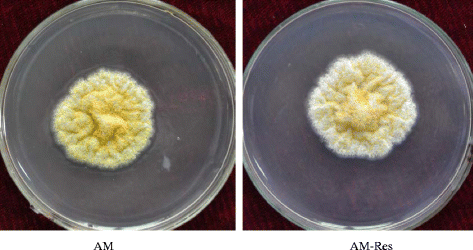Deep sequencing analysis of transcriptomes in Aspergillus flavus in response to resveratrol
- PMID: 26420172
- PMCID: PMC4589122
- DOI: 10.1186/s12866-015-0513-6
Deep sequencing analysis of transcriptomes in Aspergillus flavus in response to resveratrol
Abstract
Background: Resveratrol has been reported as a natural phytoalexin that inhibits infection or the growth of certain fungi including Aspergillus flavus. Our previous research revealed that aflatoxin production in A. flavus was reduced in medium with resveratrol. To understand the molecular mechanism of the A. flavus response to resveratrol treatment, the high-throughput paired-end RNA-Seq was applied to analyze the transcriptomic profiles of A. flavus.
Results: In total, 366 and 87 genes of A. flavus were significantly up- and down- regulated, respectively, when the fungus was treated with resveratrol. Gene Ontology (GO) functional enrichment analysis revealed that 48 significantly differentially expressed genes were involved in 6 different terms. Most genes in the aflatoxin biosynthetic pathway genes cluster (#54) did not show a significant change when A. flavus was treated with resveratrol, but 23 of the 30 genes in the #54 cluster were down-regulated. The transcription of aflA and aflB was significantly suppressed under resveratrol treatment, resulting in an insufficient amount of the starter unit hexanoate for aflatoxin biosynthesis. In addition, resveratrol significantly increased the activity of antioxidative enzymes that destroy radicals, leading to decreased aflatoxin production. Moreover, stuA, fluG, flbC, and others genes involved in mycelial and conidial development were down-regulated, which disrupted the cell's orderly differentiation and blocked conidia formation and mycelia development. The transcripts of laeA and veA were slightly inhibited by resveratrol, which may partly decrease aflatoxin production and depress conidia formation.
Conclusions: Resveratrol can affect the expression of A. flavus genes that are related to developmental and secondary metabolic processes, resulting in decreased aflatoxin production and conidia formation and could also cause abnormal mycelia development. These results provide insight into the transcriptome of A. flavus in response to resveratrol and a new clew for further study in regulation of aflatoxin biosynthesis in A. flavus.
Figures





Similar articles
-
Suppression of Aflatoxin Biosynthesis in Aspergillus flavus by 2-Phenylethanol Is Associated with Stimulated Growth and Decreased Degradation of Branched-Chain Amino Acids.Toxins (Basel). 2015 Sep 24;7(10):3887-902. doi: 10.3390/toxins7103887. Toxins (Basel). 2015. PMID: 26404375 Free PMC article.
-
Transcriptomic profiling of Aspergillus flavus in response to 5-azacytidine.Fungal Genet Biol. 2013 Jul;56:78-86. doi: 10.1016/j.fgb.2013.04.007. Epub 2013 May 1. Fungal Genet Biol. 2013. PMID: 23644151
-
Aspergillus flavus VelB acts distinctly from VeA in conidiation and may coordinate with FluG to modulate sclerotial production.Fungal Genet Biol. 2013 Sep-Oct;58-59:71-9. doi: 10.1016/j.fgb.2013.08.009. Epub 2013 Aug 29. Fungal Genet Biol. 2013. PMID: 23994319
-
Understanding the genetics of regulation of aflatoxin production and Aspergillus flavus development.Mycopathologia. 2006 Sep;162(3):155-66. doi: 10.1007/s11046-006-0050-9. Mycopathologia. 2006. PMID: 16944283 Review.
-
Molecular mechanisms of Aspergillus flavus secondary metabolism and development.Fungal Genet Biol. 2014 May;66:11-8. doi: 10.1016/j.fgb.2014.02.008. Epub 2014 Mar 5. Fungal Genet Biol. 2014. PMID: 24613992 Review.
Cited by
-
May phytophenolics alleviate aflatoxins-induced health challenges? A holistic insight on current landscape and future prospects.Front Nutr. 2022 Oct 28;9:981984. doi: 10.3389/fnut.2022.981984. eCollection 2022. Front Nutr. 2022. PMID: 36386916 Free PMC article. Review.
-
Modes-of-action of antifungal compounds: Stressors and (target-site-specific) toxins, toxicants, or toxin-stressors.Microb Biotechnol. 2023 Jul;16(7):1438-1455. doi: 10.1111/1751-7915.14242. Epub 2023 May 16. Microb Biotechnol. 2023. PMID: 37191200 Free PMC article. Review.
-
Functional Biology and Molecular Mechanisms of Host-Pathogen Interactions for Aflatoxin Contamination in Groundnut (Arachis hypogaea L.) and Maize (Zea mays L.).Front Microbiol. 2020 Mar 3;11:227. doi: 10.3389/fmicb.2020.00227. eCollection 2020. Front Microbiol. 2020. PMID: 32194520 Free PMC article. Review.
-
Advanced mycotoxin control and decontamination techniques in view of an increased aflatoxin risk in Europe due to climate change.Front Microbiol. 2023 Jan 10;13:1085891. doi: 10.3389/fmicb.2022.1085891. eCollection 2022. Front Microbiol. 2023. PMID: 36762096 Free PMC article. Review.
-
Aspergillus flavus infection triggered immune responses and host-pathogen cross-talks in groundnut during in-vitro seed colonization.Sci Rep. 2017 Aug 29;7(1):9659. doi: 10.1038/s41598-017-09260-8. Sci Rep. 2017. PMID: 28851929 Free PMC article.
References
-
- Williams JH, Phillips TD, Jolly PE, Stiles JK, Jolly CM, Aggarwal D. Human aflatoxicosis in developing countries: a review of toxicology, exposure, potential health consequences, and interventions. Am J Clin Nutrit. 2004;80(5):1106–1122. - PubMed
-
- Burow GB, Nesbitt TC, Dunlap J, Keller NP. Seed lipoxygenase products modulate Aspergillus mycotoxin biosynthesis. Mol. Plant Microbe Interact. 1997;10(3):380–387. doi: 10.1094/MPMI.1997.10.3.380. - DOI
Publication types
MeSH terms
Substances
Associated data
LinkOut - more resources
Full Text Sources
Other Literature Sources

